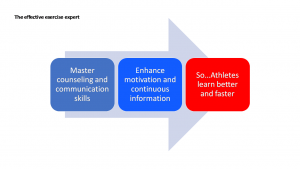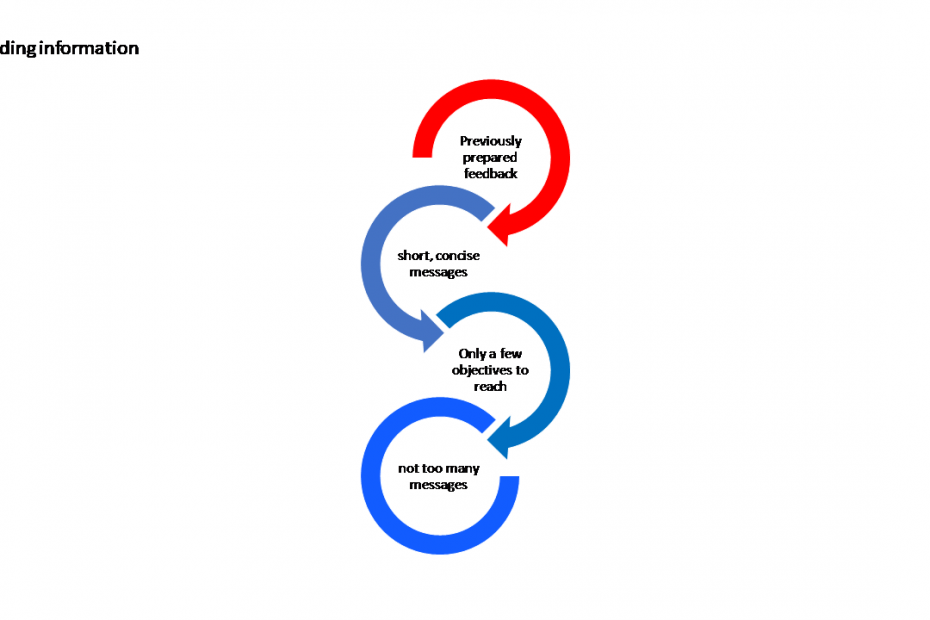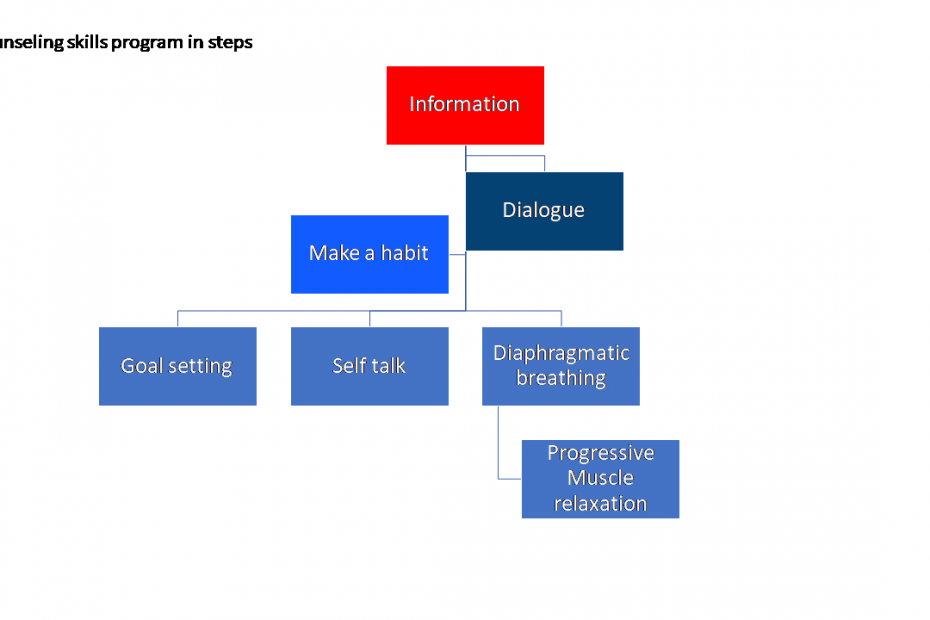
Erasmus+
“This project has been funded with support from the European Commission. This publication reflects the views only of the author, and the Commission cannot be held responsible for any use which may be made of the information contained therein”
Fostering counselling and communication skills
Upon completion of this module the reader will be able to:
- Understand how counselling and communication skills between the exercise expert and the athletes can be applied into daily training sessions
- Understand basic counselling skills that enhance communication between the exercise expert and the athletes
- Understand how effective feedback and information enhance communication and performance.
- Determine how self-awareness and cognitive ability affect communication
- Incorporate a mental training program into the training sessions of the athletes
First, it is strongly suggested to review Module 1 referring to the “Counseling techniques applied during the rehabilitation period”.
One of the great dangers an athlete can face, if not the greatest, is the risk of getting injured. That’s why its prevention and treatment constitute an essential part of the medical and performance department of the clubs. However, a part not yet explored about this risk has to do with the athlete’s psychological and social factors.
According to Andreas Ivarsson, PhD in psychology at the University of Halmstad, in Sweden, and Head of Psychology and personal development at Arsenal F.C., there are a few main mechanisms for the relationship between stress and injury risk. One of these is that stress will negatively influence the athlete’s abilities to take high qualitative decisions due to a narrowed peripheral vision. Another proposed mechanism is that stress is likely to generate higher levels of psychophysiological fatigue. An increase in fatigue might, in turn, increase the risk of becoming injured.
Read carefully the description of these techniques as they can also be used by healthy athletes for injury prevention.
Ivarsson, A., Johnson, U., Karlsson, J., Börjesson, M., Hägglund, M., Andersen, M. B., …Waldén, M. (2018). Elite female footballers’ stories of sociocultural factors, emotions, and behaviors prior to anterior cruciate ligament injury. International Journal of Sport and Exercise Psychology. Advance online publication.
Second, it is suggested to review Module 2referring to “Fostering counselling and communication skills” related to prevention training sessionswith the following order:
- Why counselling and communication are crucial for success
- Giving Feedback and providing Information as basic communication skills of the exercise expert to the athletes: Self-awareness of personal communication skills – What about cognitive ability? Does this affect communication?
- The role of the players’ mental preparation in injury prevention: Mental Skills Training as a Complement to Physical Exercise-A Basic Mental Skills Program in Action
End the session with the “Bibliography and the additional learning materials” and assess your understanding with the “Counseling and communication in soccer” quiz.
Fostering counselling and communication skills
Module 2 focuses on fostering counselling and communication skills related to prevention training sessions, providing key techniques of a toolkit to the modern soccer exercise expert (coach, trainer and athletic trainer). The core mission of this module is to build quality in terms of communication between the exercise expert and the athletes into daily training sessions for prevention strength and conditioning exercise protocols considering that athletes and exercise experts operate with interplay of thoughts, feelings, physiology, and actions. This interaction is crucial for performance and well-being and becomes more valuable especially as soccer is by definition a sport characterised by adversity.
In that module it is taken into consideration the fact that athletes (players) must learn to view adversity as a natural part of their sport (soccer) and manage to cope with dedication and commitment. Therefore, it is strongly suggested that a. communication skills should be considered by the exercise experts while guiding their athletes following the rule that achieving good results is accomplished through a focus on the process, not only on the outcome and b. the development of mental skills should be integrated into daily training sessions of healthy athletes for injury prevention
Why counselling and communication are crucial for success?
The influence of the coaching staff is crucial for the performance of a team and its individuals, particularly with regard to the technical, tactical, physical and psychological aspects of performance. As with all sports, the impact of mental preparation and the well-being of athletes and team performance has gained increased focus in recent years, as it has now been recognized how much psychology matters (Nesti, 2010).
Especially in young athletes, one of the three fundamental factors related to peak performance is defined as the individual psychological components for peak performance and well-being (Willis, 2017). The same author refers to elite players as not simple or one-dimensional beings. “They are versatile and function within a highly complex social and organizational environments, which exerts major influences on them and their performance”. It is proved helpful to incorporate all psychological topics and variables into a unifying model of psychological preparation to peak performance (Hardy et al, 1996). In this context, communication skills are also considered as a key definer of the culture of excellence, the other fundamental factor for peak performance in soccer (Willis, 2017). It directly affects the athletes’ ability to be productive, their sense of accomplishment, and even their quality of life. Working daily at being excellent has an impact on how athletes interact with each other and how they handle success and failure (Nesti, 2010). When positive, the values, mindsets and behaviours that constitute an environment foster success, and can influence the confidence of individual players, their teammates, their coaches and the team as a whole.
As such, the exercise expert’s profession working with soccer teams becomes more and more complicated. Besides an outstanding knowledge of the gameplay, it is necessary to fully master counselling and communication skills and apply them through motivation and continuous information to help players learn better and faster. An effective coach not only delivers technical instructions, but he/she must also know how to provide learning for the people they work with. The information that does not reach players adequately is useless information.

Giving feedback and providing Information as basic communication skills of the exercise expert to the athletes
Feedback, for the purposes of our project, informs the athletes about what they have to do in order to execute correctly a specific task, pointing them out the achieved goal, rhythm, technique etc of this specific task. What the exercise expert wants to accomplish first, is that the player associates the proposed behaviour to its consequence. Second, it is about reinforcing the action chosen by a player to solve the “situation” in which they have been successful. “If the coach has told me what I have done is right because I have achieved what he wanted, I will repeat it”, the athlete seems to think.
In specific, coaches use verbal instruction to focus an athlete’s attention on pertinent aspects of a skill. Depending on the context, this focus of attention can be either internal or external (Benz et al, 2016). An internal instruction directs focus to body movements, joint angles, or the action itself, whereas an external instruction pertains to the desired outcome, an implement (golf club, ball, etc.) or the environment (Benz et al, 2016; Wulf et al, 1998). Choosing words carefully is critical as proper instructions can “load the working memory,” priming the mind for processing and attention appropriate for that skill (Furley et al, 2016). This study demonstrates that attentional focus instructions significantly influence several CMJ jump variables (including jump height). The finding that instructions can alter efficiency and performance of a skill indicate that they need to be designed and applied to suit the context.
A recent research (Januário et al, 2016) has analysed how the players retain the feedback provided by the coaches. The study followed the behavior of 12 coaches (8 men and 4 women, all of them with more than 5 years of experience) and 342 players (246 men and 96 women) aged between 10 and 18 during 18 training sessions. The footballers were classified into 4 groups considering the category in which they competed: local, regional, national, or international level. In total, 1728 feedbacks issued by the coaches during the training sessions were analyzed. The results revealed several conclusions of great practical relevance:
- In 65.5% of the feedbacks, the players had difficulties to reproduce completely the coaches’ instructions. That is to say, only 34.5% of the feedbacks were completely retained;
- The more the coach provided different instructions, the lower the feedback retention. The average of instructions provided by the coaches was 3.96, with a total of 28.91 words.
- The higher the level of the players, the higher the feedback retention.
The practical applications of this study indicated that coaches should very much take into consideration some specific points at the time of providing information or feedback to the players:
- It is very dangerous to provide too many messages (feedbacks) to the athletes during the tasks. Attention is limited and providing much information usually produces that a good part of the instructions received is forgotten.
- The design of the sessions should include a few objectives to reach. The lower the age or level of the athletes, it is recommendable to include only 1 or 2 objectives in each session; when the level is higher, some more can be added. (examples from the videos)
- Coaches should have previously prepared the feedbacks they are going to provide to reinforce the achievement of the objectives planned in the session, e.g technical correctness.
- Short, concise messages with an understandable language usually reach players more effectively.
Take home message!
When highlighting the main points of the appropriate technique, we help the athletes understand what they must do in order to execute correctly for safety and enhanced technique or performance. We are helping them to find out the “solution” to a certain “situation”, i.e the way to execute a skill effectively.

Self-awareness of personal communication skills
Some exercise experts are effective communicators, others develop skill through life experiences and others make conscious efforts to become effective in communication. Those who are effective, are able to express their messages clearly, listen effectively, while trying also to observe non-verbal messages. They are committed to understanding the needs of their athletes/players and producing messages to negotiate mutual understanding. If their athletes don’t demonstrate understanding, then effective communicators are trying to become more facilitative and guarantee effective communication.
Communication based on stereotypical judgements limits the possibility of relating to the whole player, potentially resulting in misunderstandings. It is important for the exercise expert to develop attitudes of unconditional positive regard for all athletes who see their assistance. The key for effectiveness is the non-judgemental communication.
What about cognitive ability? Does this affect communication?
Cognitive ability is the ability to process, store and retrieve information using reasoning, interpretation, perception, problem-solving, learning and memory. It is imperative that the exercise expert and the athlete posses’ basic cognitive abilities to negotiate mutual understanding and produce effective and emotionally comfortable interactions (Lamothe et al, 2014). It is also important to understand that when feeling vulnerable or stressed, the athletes may experience temporary deterioration in their cognitive processing skills. Imagine what is happening when an athlete is tired or exhausted!!!
An important cognitive ability is the concentration or attend throughout the communicative interaction. It is important to understand the limits of attention span of the athletes whether their cognitive skills are declining (e.g when they are tired or stressed) and that allows the exercise expert to adjust its communication as necessary.
If someone, athlete or exercise expert, does not understand what is being communicated, regardless of the reasons for the lack of comprehension, they will cease listening. In such situations, it is less possible to negotiate meaning and mutual understanding. Interpreting the non-verbal cues related to potential comprehension is sometimes useful but may be unreliable in many situations. To confirm adequate comprehension the exercise expert should ask the athlete to repeat, in his own words, the meaning they ascribe to the delivered message.
Remember also that emotional states may restrict cognitive functioning regardless of the considered cognitive abilities of the athlete.
Non-verbal communication without words is often more important than spoken words when deciding the meaning of a message. There are two main elements of non-verbal communication. The first is the body language, which includes fascial expression, eye contact, gesture and proximity. The exercise expert should always observe the body language and fascial expression of its athletes in order to be reassured that the verbal messages received agree with non-verbal communication (e.g remember your athletes’ expressions whey they are tired, or they feel some unknown pain while exercising).
The other element refers to the non-verbal characteristics of the voice; they include volume, pitch, rate, emphasis, pauses, tone and non-verbal sounds such as laughing or moaning. Alternative forms of communication are required to be used by the exercise expert but always the non-verbal messages should complement verbal messages. Exercise experts use several non-verbal characteristics of the voice in order to motivate their athletes to try more or to be more concentrated!
Emphasis is also a characteristic of the voice that can be used to change meaning. Emphasis refers to the stress placed on words within phrases or sentences. When used skillfully, it is a powerful communication tool, especially in case of teaching a new skill, or improving technique elements.
Pauses when speaking occur within sentences as well as in conversations. They provide opportunities for taking a breath or in our occasion for checking the athletes’ technique. For the athletes, pauses of the coach allow them to process, understand and perhaps consider any questions they might want to ask the exercise expert. In the same time, pauses allow the coach to prepare the next word cue/feedback to the athlete, to decide whether to clarify the words or to ask if the athlete requires clarification, or in some cases to ask whether they are hearing and understanding. Such pauses require the exercise expert to focus completely on the athlete on both the verbal and non-verbal aspects of their message-feedback, continuing to engage by either nodding the head or vocalizing (mmm) to indicate focused listening.
Tone. Emphasis and tone may occur together. Tone is usually expressed through changes in pitch, volume or duration of a word. The tone of voice can be used to change meaning in particular circumstances.

Take home message!
Just as the athlete’s bodyand the mind work together on the playing field toproduce effective performance, the body and the mindcan be trained to work together in a manner that willmake an athlete less susceptible to injury. The athletic trainer who promotes mental toughness and who understands the role of mental skills in minimizing the risk of injury is in a unique position to help athletes. Regular contact with the athlete provides a mechanism for reinforcement of learning and reminders to utilize stress management skills.
Bibliography and the additional learning materials
Ahern D, Lohr B. (2003) Psychosocial factors in sports injury rehabilitation.Clin in Sports Med.;16 (4):755-768.
Benz JA,WinkelmanN, Porter J, andNimphius S. (2016) Coaching instructions andcues for enhancing sprint performance. J StrengthCondRes 38:1–11.
Blakeslee ML, Goff DM. (2007) The effects of a mental skills training packageon equestrians. Sport Psychol;21(3):288-301.
Canadian Sports Center Calgary. Menu of Services. Canadian SportsCenter website (2008) http://www.canadiansportcentre.com/docs/MenuofServices2008.pdf.Accessed
Danish SJ, Forneris T, Wallace I. (2005) Sport-based life skills programmingin the schools. J Applied School Psychol;21(2):41-62.
Davis JO. (1991) Sports injuries and stress management: an opportunity forresearch. Sport Psychol;5:175-182.
Furley P and Wood G. (2016) Working memory, attentional control, and expertisein sports: A review of current literature and directions for futureresearch. J Appl Res Mem Cogn 5: 415–425.
Gjyn O’Toole (2020) Communication – eBook: Core Interpersonal Skills for Healthcare ProfessionalsELSEVIER HEALTH SCIENCES. ISBN 0729587746, 9780729587747
Gucciardi DF, Dimmock JA. (2008) Choking under pressure in sensorimotorskills: conscious processing or depleted attentional resources? PsychologSport Exerc.;9(1):45-59.
Hardy, L., Jones, G., & Gould, D. (1996). Understanding psychological preparation for sport:Theory and practice. Chichester, UK: Wiley.
Januário, N., Rosado, A., Mesquita, I., Gallego, J. y Aguilar-Parra, J.M. (2016). Determinants of feedback retention in soccer players. Journal of Human Kinetics,51: 235-241.
Jordet G. (2005) Perceptual training in soccer: an imagery intervention studywith elite players. J Appl Sport Psychol.;17(2),140-156.
Lamothe, M.B, Boujut, E., Senasni, F, et al (2014) To be or not to be empathic: the combined role of empathic concern and perspective taking in understanding burnout in general practice. BMC Family Practice 15 (1), 15-30.
Meyers MC, Bourgeois AE, LeUnes A, Murray N. (1999) Mood and psychologicalskills of elite and sub-elite equestrian athletes. J Sport Behav;22(3):399-409.
Naylor A. (2009) Human Kinetics – Athletic Therapy Today 14(2), pp. 27-29.
Nesti, M. (2010) Psychology in Football: Working with elite and professional players, London: Routledge.
Nideffer RM, Sagal M. (2001)Attention control training principles. In: AppliedSport Psychology: Personal Growth to Peak Performance (4th ed.) J.M.Williams, Ed. Mountain View, CA: Mayfield Publishing Company, pp. 312-332.
Papacharisis V, Goudas M, Danish SJ, Theodorakis Y. (2005)The effectivenessof teaching a life skills program in a sport context. J Applied SportPsychol;17(3):240-246.
Patrick TD. HrycaikoDW. (1998) Effects of a mental training package on anendurance performance. The Sport Psychol;12,283-299.
Thelwell, RC, Maynard IW. (2003) The effect of mental skills trainingpackage on gymnasium triathalon performance. Sport Psycholog;15(2):127-141.
Willis, A. (2017) 4 mental skills to develop in young athletes https://www.workinsports.com/blog/4-mental-skills-to-develop-in-young-athletes/
WulfG,HoeßM, and PrinzW. Instructions formotor learning:Differentialeffects of internal vs. external focus of attention (1998) J Mot Behav 30:169–179.
Cognitive Therapy and Research 1991; 15: 1-19.
[ays_quiz id=’19’]
Erasmus+
“This project has been funded with support from the European Commission. This publication reflects the views only of the author, and the Commission cannot be held responsible for any use which may be made of the information contained therein.”
